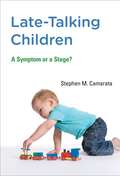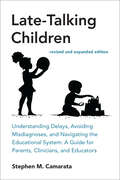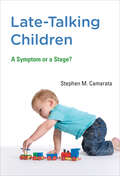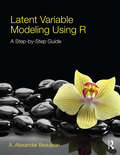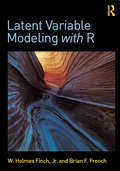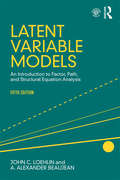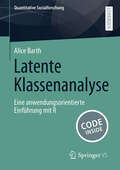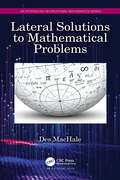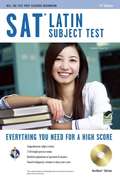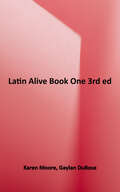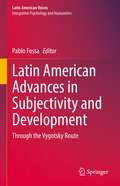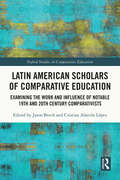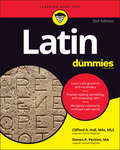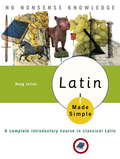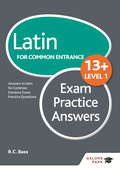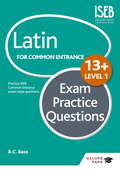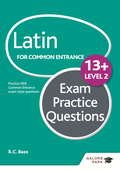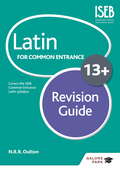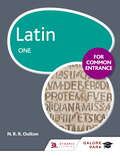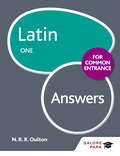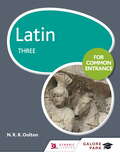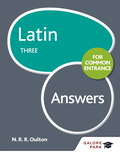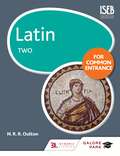- Table View
- List View
Late-Talking Children
by Stephen M. CamarataWhen children are late in hitting developmental milestones, parents worry. And no delay causes more parental anxiety than late talking, which is associated in many parents' minds with such serious conditions as autism and severe intellectual disability. In fact, as children's speech expert Stephen Camarata points out in this enlightening book, children are late in beginning to talk for a wide variety of reasons. For some children, late talking may be a symptom of other, more serious, problems; for many others, however, it may simply be a stage with no long-term complications. Camarata describes in accessible language what science knows about the characteristics and causes of late talking. He explains that today's greater awareness of autism, as well as the expanded definition of autism as a "spectrum" of symptoms, has increased the chances that a late-talking child will be diagnosed -- or misdiagnosed -- with autism. But, he reminds us, late talking is only one of a constellation of autism symptoms. Although all autistic children are late talkers, not all late-talking children are autistic. Camarata draws on more than twenty-five years of professional experience diagnosing and treating late talkers -- and on his personal experience of being a late talker himself and having a late-talking son. Camarata offers parents valuable guidance on seeking treatment, advising them to get second and third opinions if necessary, and warning them against false diagnoses, unqualified practitioners, and ineffective therapies. He provides information that will help parents navigate the maze of doctors, speech therapists, early childhood services, and special education; and he describes the effect that late talking may have on children's post-talking learning styles.
Late-Talking Children, revised and expanded edition: Understanding Delays, Avoiding Misdiagnoses, and Navigating the Educational System: A Guide for Parents, Clinicians, and Educators
by Stephen M. CamarataA revised and expanded edition of the bestselling guide to late-talking children for parents, clinicians, and educators, from a leading authority on development and disabilities.Every year in America, more than half a million parents of late-talking children face agonizing questions: What should I do if my two- or even three-year-old has not yet begun to talk? Should I worry that my child is autistic or intellectually disabled? Are expensive therapies or medications needed? Will my child ever speak normally? In this revised and expanded edition of the essential resource on the subject, Late-Talking Children, Stephen Camarata—the parent of a late-talking child and a late talker himself—provides clear, sensible, and compassionate answers for parents, clinicians, and educators, drawing on his more than three decades of experience diagnosing and treating the &“late-talking syndrome&” as well as the best science available today.
Late-Talking Children: A Symptom or a Stage? (The\mit Press Ser.)
by Stephen M. CamarataWhat parents need to know about the causes and treatment of children's late talking: how to avoid misdiagnoses, navigate the educational system, and more.When children are late in hitting developmental milestones, parents worry. And no delay causes more parental anxiety than late talking, which is associated in many parents' minds with such serious conditions as autism and severe intellectual disability. In fact, as children's speech expert Stephen Camarata points out in this enlightening book, children are late in beginning to talk for a wide variety of reasons. For some children, late talking may be a symptom of other, more serious, problems; for many others, however, it may simply be a stage with no long-term complications.Camarata describes in accessible language what science knows about the characteristics and causes of late talking. He explains that late talking is only one of a constellation of autism symptoms. Although all autistic children are late talkers, not all late-talking children are autistic. Camarata draws on more than twenty-five years of professional experience diagnosing and treating late talkers—and on his personal experience of being a late talker himself and having a late-talking son. He provides information that will help parents navigate the maze of doctors, speech therapists, early childhood services, and special education; and he describes the effect that late talking may have on children's post-talking learning styles.
Lateinische Texte und ihre Schwierigkeit: Eine empirische Untersuchung
by Thomas LaursIn diesem Buch wird ein neuartiger Ansatz zur Vorhersage der Schwierigkeit lateinischer Texte entwickelt, der die sprachliche Analyse mit Methoden des maschinellen Lernens verbindet. Grundlage der Untersuchung sind lateinische Texte unterschiedlicher Schwierigkeitsstufen, deren Lesbarkeit von Studenten subjektiv eingeschätzt worden ist und durch eine Vielzahl sprachlicher Variablen quantitativ erfasst wird. Ein zentrales Ziel der Arbeit ist es, ein Modell zu erstellen, das auf Basis der sprachlichen Variablen und der Einschätzungen der Probanden die Schwierigkeit eines lateinischen Textes bewerten kann. Hierzu wurden sowohl klassische linguistische Methoden als auch moderne NLP-Tools eingesetzt. Untersucht werden sprachliche Parameter aus den Bereichen Lexik und Semantik, Morphologie, Syntax und Diskurslinguistik. Ein besonderes Augenmerk liegt auch auf der Unterscheidung zwischen prosaischen und poetischen Texten. Die Ergebnisse tragen nicht nur zur Schwierigkeitsbestimmung lateinischer Texte bei, sondern eröffnen auch neue Perspektiven für die Didaktik des Lateinischen. Sie zeigen, wie digitale Methoden die Bewertung und Auswahl von Lehrmaterialien erleichtern können und leisten zugleich einen Beitrag zur Verbindung von klassischer Philologie und moderner Datenwissenschaft.
Latent Variable Modeling Using R: A Step-by-Step Guide
by A. Alexander BeaujeanThis step-by-step guide is written for R and latent variable model (LVM) novices. Utilizing a path model approach and focusing on the lavaan package, this book is designed to help readers quickly understand LVMs and their analysis in R. The author reviews the reasoning behind the syntax selected and provides examples that demonstrate how to analyze data for a variety of LVMs.? Featuring examples applicable to psychology, education, business, and other social and health sciences, minimal text is devoted to theoretical underpinnings. The material is presented without?the use of matrix algebra. As a whole the book prepares readers to write about and interpret LVM results they obtain in R. Each chapter features background information, boldfaced key? terms defined in the glossary, detailed interpretations of R output, descriptions of how to write the analysis of results for publication, a summary, R based practice exercises (with solutions included in the back of the book), and references and related readings. Margin notes help readers better understand LVMs and write their own R syntax. Examples using data from published work across a variety of disciplines demonstrate how to use R syntax for analyzing and interpreting results. R functions, syntax, and the corresponding results appear in gray boxes to help readers quickly locate this material. A unique index helps readers quickly locate R?functions, packages, and datasets. The book and accompanying website at http://blogs.baylor.edu/rlatentvariable/ provides all of the data for the book’s examples and exercises as well as R syntax so readers can replicate the analyses. The book reviews how to enter the data into R, specify the LVMs, and obtain and interpret the estimated parameter values. The book opens with the fundamentals of using R including how to download the program, use functions, and enter and manipulate data. Chapters 2 and 3 introduce and then extend path models to include latent variables. Chapter 4 shows readers how to analyze a latent variable model with data from more than one group, while Chapter 5 shows how to analyze a latent variable model with data from more than one time period. Chapter 6 demonstrates the analysis of dichotomous variables, while Chapter 7 demonstrates how to analyze LVMs with missing data. Chapter 8 focuses on sample size determination using Monte Carlo methods, which can be used with a wide range of statistical models and account for missing data. The final chapter examines hierarchical LVMs, demonstrating both higher-order and bi-factor approaches. The book concludes with three Appendices: a review of common measures of model fit including their formulae and interpretation; syntax for other R latent variable models packages; and solutions for each chapter’s exercises. Intended as a supplementary text for graduate and/or advanced undergraduate courses on latent variable modeling, factor analysis, structural equation modeling, item response theory, measurement, or multivariate statistics taught in psychology, education, human development, business, economics, and social and health sciences, this book also appeals to researchers in these fields. Prerequisites include familiarity with basic statistical concepts, but knowledge of R is not assumed.
Latent Variable Modeling with R
by W. Holmes Finch Brian F. FrenchThis book demonstrates how to conduct latent variable modeling (LVM) in R by highlighting the features of each model, their specialized uses, examples, sample code and output, and an interpretation of the results. Each chapter features a detailed example including the analysis of the data using R, the relevant theory, the assumptions underlying the model, and other statistical details to help readers better understand the models and interpret the results. Every R command necessary for conducting the analyses is described along with the resulting output which provides readers with a template to follow when they apply the methods to their own data. The basic information pertinent to each model, the newest developments in these areas, and the relevant R code to use them are reviewed. Each chapter also features an introduction, summary, and suggested readings. A glossary of the text’s boldfaced key terms and key R commands serve as helpful resources. The book is accompanied by a website with exercises, an answer key, and the in-text example data sets. Latent Variable Modeling with R: -Provides some examples that use messy data providing a more realistic situation readers will encounter with their own data. -Reviews a wide range of LVMs including factor analysis, structural equation modeling, item response theory, and mixture models and advanced topics such as fitting nonlinear structural equation models, nonparametric item response theory models, and mixture regression models. -Demonstrates how data simulation can help researchers better understand statistical methods and assist in selecting the necessary sample size prior to collecting data. -www.routledge.com/9780415832458 provides exercises that apply the models along with annotated R output answer keys and the data that corresponds to the in-text examples so readers can replicate the results and check their work. The book opens with basic instructions in how to use R to read data, download functions, and conduct basic analyses. From there, each chapter is dedicated to a different latent variable model including exploratory and confirmatory factor analysis (CFA), structural equation modeling (SEM), multiple groups CFA/SEM, least squares estimation, growth curve models, mixture models, item response theory (both dichotomous and polytomous items), differential item functioning (DIF), and correspondance analysis. ?The book concludes with a discussion of how data simulation can be used to better understand the workings of a statistical method and assist researchers in deciding on the necessary sample size prior to collecting data.? A mixture of independently developed R code along with available libraries for simulating latent models in R are provided so readers can use these simulations to analyze data using the methods introduced in the previous chapters. Intended for use in graduate or advanced undergraduate courses in latent variable modeling, factor analysis, structural equation modeling, item response theory, measurement, or multivariate statistics taught in psychology, education, human development, and social and health sciences, researchers in these fields also appreciate this book’s practical approach. The book provides sufficient conceptual background information to serve as a standalone text.? Familiarity with basic statistical concepts is assumed but basic knowledge of R is not.
Latent Variable Models: An Introduction to Factor, Path, and Structural Equation Analysis, Fifth Edition
by A. Alexander Beaujean John C. LoehlinLatent Variable Models: An Introduction to Factor, Path, and Structural Equation Analysis introduces latent variable models by utilizing path diagrams to explain the relationships in the models. This approach helps less mathematically-inclined readers to grasp the underlying relations among path analysis, factor analysis, and structural equation modeling, and to set up and carry out such analyses. This revised and expanded fifth edition again contains key chapters on path analysis, structural equation models, and exploratory factor analysis. In addition, it contains new material on composite reliability, models with categorical data, the minimum average partial procedure, bi-factor models, and communicating about latent variable models. The informal writing style and the numerous illustrative examples make the book accessible to readers of varying backgrounds. Notes at the end of each chapter expand the discussion and provide additional technical detail and references. Moreover, most chapters contain an extended example in which the authors work through one of the chapter’s examples in detail to aid readers in conducting similar analyses with their own data. The book and accompanying website provide all of the data for the book’s examples as well as syntax from latent variable programs so readers can replicate the analyses. The book can be used with any of a variety of computer programs, but special attention is paid to LISREL and R. An important resource for advanced students and researchers in numerous disciplines in the behavioral sciences, education, business, and health sciences, Latent Variable Models is a practical and readable reference for those seeking to understand or conduct an analysis using latent variables.
Latente Klassenanalyse: Eine anwendungsorientierte Einführung mit R (Quantitative Sozialforschung)
by Alice BarthDas Buch bietet eine kompakte, anwendungsorientierte Einführung in die Technik der latenten Klassenanalyse. Grundlagen des Verfahrens sowie Voraussetzungen, praktische Anwendung und Ergebnisinterpretation werden verständlich erläutert. Die Analyse latenter Klassen ist ein statistisches Klassifikationsverfahren, bei dem mehrere kategoriale, manifeste Variablen zu vorher unbeobachteten Gruppen zugeordnet werden. So können z.B. aus einer Vielzahl von Variablen Typologien entwickelt werden. Für die Durchführung der Analysen wird die Open Source-Statistikumgebung R genutzt. Die verwendeten Syntaxbefehle sowie die Ausgabe der Ergebnisse werden erläutert, zusätzlich sind die kommentierte R-Syntax sowie Beispieldaten als elektronisches Zusatzmaterial im GitHub-Repositorium des Buches auf SpringerLink verfügbar. Die in den Beispielen verwendeten Daten haben keine Zugangsbeschränkung und können kostenfrei heruntergeladen werden, um die Analysen selbst nachzuvollziehen.
Lateral Solutions to Mathematical Problems (AK Peters/CRC Recreational Mathematics Series)
by Desmond MacHaleLateral Solutions to Mathematical Problems offers a fresh approach to mathematical problem solving via lateral thinking. Lateral thinking has long been used informally by good mathematics teachers and lecturers to spice up their material and interest their students in the more artistic aspects of mathematical problem solving. In this book, the author attempts to carry out this process formally, with reference to specific, non-technical problems that are easily understood and explained at an intermediate level.This book is appropriate for interested high school students, undergraduates and postgraduates, looking for relief from technical material and also looking for insight into the methodology of mathematics; for teachers and lecturers looking for a novel approach to course material; and anyone interested in both mathematics and lateral thinking.
Latin (SAT PSAT ACT (College Admission) Prep Series)
by Ronald B. Palma<P>Taking the SAT Latin Subject Test? <P>Then REA's SAT Subject Test: Latin Test Prep with Practice Tests on CD is just for you! <P>Written by an experienced Latin teacher, this second edition of our bestselling SAT Subject Test: Latin test prep includes a comprehensive review of covers all language areas appearing on the actual exam including coverage of declensions, conjugations, sentence structure, and more. Each chapter contains numerous examples and practice questions, and tips that help students study smarter and boost their test scores. <P>The book includes two full-length practice tests that replicate the actual exam's question format. Both of the book's practice exams are featured on our TestWare CD with the most powerful scoring and diagnostic tools available today. Automatic scoring and instant reports help you zero in on the topics and types of questions that give you trouble now, so you'll succeed when it counts. <P>Detailed explanations of answers help you identify your strengths and weaknesses. We don't just say which answers are right - we also explain why the other answer choices are incorrect - so you'll be prepared on test day. <P>The book also includes study tips, strategies, and confidence-boosting advice you need for test day. <P>REA's test prep is a must for any high school student taking the SAT Latin Subject Test!
Latin Alive! (Latin Alive Series #Book One)
by Karen Moore Gaylan DuBoseStudents will be delighted by what they learn in each new chapter of Latin Alive!, Book One, and they will learn to see that Latin is everywhere around them. As the first text in a three-year series, it is a rigorous and thorough introduction to this great language and is designed to engage upper school (middle and high school) student. Brimming with relevant facts and stories this text offers something for everyone. A Teacher’s Edition including answer keys, teacher’s helps and additional activities is available separately.
Latin American Advances in Subjectivity and Development: Through the Vygotsky Route (Latin American Voices)
by Pablo FossaThis is the first book in English to show how the work of Lev Vygotsky gave rise to a prolific and original school of cultural-historical psychology in Latin America. In recent decades, Latin American researchers have expanded Vygotskyan conceptualizations and applied practical theory to psychological and educational research and practice, but until now this production remained virtually unknown for English speaking audiences since it has been mainly published in Spanish and Portuguese. This timely volume contributes to change this situation by presenting a panoramic picture of the state of the art of cultural-historical psychology in Latin America. The book is divided in two parts. The first part shows how Latin American researchers used Vygotsky’s work to develop new theoretical elaborations and empirical advances to deal with different political, social and cultural problems in the region. The second part presents an overview of the current state of cultural-historical psychology in Latin America. Throughout its 15 chapters, the book shows how Latin American researchers contributed to the studies of different aspects of the cultural-historical theoretical conception of the development of higher psychological functions, such as concept formation, inner speech, zone of proximal development and imagination, and how these theoretical elaborations have been applied to research and practice in fields such as sociocultural psychology, developmental psychology, psychotherapy and education in Argentina, Brazil, Chile, Colombia, Cuba, Mexico, Peru and Puerto Rico.Latin American Advances in Subjectivity and Development - Through the Vygotsky Route will be an invaluable resource to researchers, students and practitioners in the fields of psychology, education and other social sciences interested in discovering or learning more about the original Latin American school of cultural-historical psychology.
Latin American Scholars of Comparative Education: Examining the Work and Influence of Notable 19th and 20th Century Comparativists (Oxford Studies in Comparative Education)
by Cristina Alarcón LópezProviding one of the first accounts in English of the work of the founding scholars of comparative education in Latin America from the 19th and 20th centuries, this book presents a detailed analysis of their influence on the field and highlights the pivotal role played by each scholar in the development of comparative education in the Global South.The book chiefly comprises biographical contributions about the achievements of significant Latin American scholars both in terms of critical historical-epistemological traditions and educational reforms that impacted the development of Latin American societies and education systems. Across 13 chapters, the book discusses travellers who contributed to the post-independence period of nation-building; progressive reformers inspired by the work of John Dewey; and finally, scholars who played a key role in the institutionalisation of the field of comparative education in the region. Novel in its focus, even considering publications in Spanish and Portuguese, the book ultimately appeals to the current interest in understanding comparative education and its history as a worldwide project.Exploring the history of comparative education beyond the confines of established Anglo-European accounts, this volume will be of great interest to researchers and scholars in comparative and international education, history of education and Latin American studies.
Latin For Dummies
by Clifford A. Hull Steven R. PerkinsMaster the basics of a lyrical and useful language Even though most people don’t use Latin anymore, it used to be spoken by millions of people from across the ancient world. It later morphed into new languages we still use today! In Latin For Dummies, you’ll take a tour through the language of ancient Rome. Beginning with Latin you may already know, like “carpe diem” and “quid pro quo,” the book walks you through essential Latin grammar and everyday Latin phrases. It also explores how Latin shaped and molded modern languages, including English. In this book, you’ll find: Lessons to learn Latin grammar and vocabulary Practices for reading, translating, and composing Latin Tips to recognize commonly confused Latin words Latin For Dummies proves that learning Latin, while challenging, can be fun and exciting too! It’s perfect for first timers interested in the ancient language and anyone who wants to learn more about ancient Roman history and culture.
Latin Made Simple
by Doug JuliusLatin Made Simple makes it easy to increase your understanding of the language and the many ways it has enriched our culture. The perfect primer for anyone who wants to be able to read classical Latin or learn the basics to enhance their vocabulary, this complete course presents Latin grammar clearly and plainly. Void of all non-essentials and refreshingly easy to understand, Latin Made Simple includes: Complete Latin grammar; Extensive vocabulary; Review quizzes; Complete answer key; Practice readings; Examination of Latin words in the English language; Timeline of Roman History and Literature; A helpful verb chart; English/Latin Dictionary.
Latin for Common Entrance 13+ Exam Practice Answers Level 1
by R. C. BassExam Board: ISEBLevel: 13+Subject: LatinFirst Teaching: September 2014First Exam: Autumn 2015This book contains comprehensive answers and a suggested mark scheme to the exercises in Latin for Common Entrance 13+ Exam Practice Questions Level 1- Endorsed by ISEB- Contains both the Latin and English translations to save you time marking work and to help identify areas that require further study- Includes answers for all exercises so that pupils understand how full their responses need to be to achieve top marks
Latin for Common Entrance 13+ Exam Practice Questions Level 1 (for the June 2022 exams)
by R. C. BassPlease note, this resource is suitable for the exams up to June 2022. New revision resources will be available from Spring 2022 for the exams from November 2022.Exam Board: ISEBLevel: 13+Subject: LatinFirst Teaching: September 2014First Exam: Autumn 2015This set of exam-style questions provides pupils with a wealth of practice for 13+ ISEB Latin Common Entrance exams at Level 1. The huge range of questions covers translation, grammar and vocabulary, enabling pupils to familiarise themselves with the types of questions they will face in the real exam- Endorsed by ISEB- Prepares pupils for Latin Common Entrance and Level 1 entrance exams- Features extensive practice in comprehension and translation both from English to Latin and Latin to English- Includes a complete vocabulary list for Level 1 to serve as a checklist for pupils
Latin for Common Entrance 13+ Exam Practice Questions Level 2 (for the June 2022 exams)
by R. C. BassPlease note, this resource is suitable for the exams up to June 2022. New revision resources will be available from Spring 2022 for the exams from November 2022.Exam Board: ISEBLevel: 13+Subject: LatinFirst Teaching: September 2014First Exam: Autumn 2015This set of exam-style questions provides pupils with a wealth of practice for 13+ ISEB Latin Common Entrance exams at Level 2. The huge range of questions covers translation, grammar and vocabulary, enabling pupils to familiarise themselves with the types of questions they will face in the real exam -Endorsed by ISEB- Prepares pupils for Latin Common Entrance and Level 2 entrance exams- Features extensive practice in comprehension and translation both from English to Latin and Latin to English- Includes a complete vocabulary list for Level 2 to serve as a checklist for pupils
Latin for Common Entrance 13+ Exam Practice Questions Level 3 (for the June 2022 exams)
by R. C. BassPlease note, this resource is suitable for the exams up to June 2022. New revision resources will be available from Spring 2022 for the exams from November 2022.Exam Board: ISEBLevel: 13+Subject: LatinFirst Teaching: September 2014First Exam: Autumn 2015This set of exam-style questions provides pupils with a wealth of practice for 13+ ISEB Latin Common Entrance exams at Level 3. The huge range of questions covers translation, grammar and vocabulary, enabling pupils to familiarise themselves with the types of questions they will face in the real exam- Endorsed by ISEB- Prepares pupils for Latin Common Entrance and Level 3 entrance exams- Features extensive practice in comprehension and translation both from English to Latin and Latin to English- Includes a complete vocabulary list for Level 3 to serve as a checklist for pupils
Latin for Common Entrance 13+ Revision Guide (for the June 2022 exams)
by N. R. OultonPlease note, this resource is suitable for the exams up to June 2022. New revision resources will be available from Spring 2022 for the exams from November 2022.Exam Board: ISEBLevel: 13+Subject: LatinFirst Teaching: September 2014First Exam: Autumn 2015Updated for the latest ISEB Classics syllabus, this book consolidates all the Latin grammar pupils need to know for the exam into one book, making it an indispensable revision resource for any pupil. It contains clear explanations of all topics, including information on the non-linguistic exam, followed by 'Test Yourself' questions so that pupils can ensure they have understood what they have learnt.- Endorsed by ISEB- Information is presented clearly and methodically to ensure it is accessible for pupils- Includes information on the linguistic and non-linguistic sections so pupils are fully prepared for the Level 1, 2 and 3 ISEB Latin exams- 'Test Yourself' exercises are included so pupils can check their progress- Ideal for using alongside Latin Vocabulary for Key Stage 3 and Common Entrance
Latin for Common Entrance One
by N. R. OultonExam Board: ISEBLevel: 13+Subject: LatinFirst Teaching: September 2014First Exam: Autumn 2015Latin for Common Entrance One is the first book in Nicholas Oulton's new Latin course, combining your favourite elements of So You Really Want to Learn Latin, Latin Prep and Ab Initio, but now it maps precisely to the new ISEB syllabus and contains passages and question types in line with the revised Common Entrance exam.This extensively revised book is ideal for Latin beginners, introducing pupils to regular verbs and sum in the present, imperfect and perfect tenses, nouns of the first two declensions, adjectives of the 1st/2nd declension, prepositions and numerals. All the grammar, vocabulary and syntax on the Level 1 syllabus is covered and passages for translation are geared towards the Greek Mythology and City of Rome topics for the non-linguistic studies element of the ISEB syllabus. Written specifically for prep schools, this book includes solid grammar explanations, intentionally challenging content and twice as many practice exercises compared to the previous series, ensuring pupils have understood the material coveredLatin for Common Entrance One Answers are available to buy separately as a PDF download
Latin for Common Entrance One Answers
by N. R. OultonThis PDF download provides a complete set of answers to the exercises in Latin for Common Entrance One.- Clear layout saves time marking work - Enables efficient assessment of pupils' strengths and weaknesses - Advice and guidance develops pupils' use of the languagePlease note that as a PDF download, this product is non-refundable.
Latin for Common Entrance Three
by N. R. OultonExam Board: ISEBLevel: 13+Subject: LatinFirst Teaching: September 2014First Exam: Autumn 2015Latin for Common Entrance Three is the final book in Nicholas Oulton's new Latin course, combining your favourite elements of So You Really Want to Learn Latin, Latin Prep and Ab Initio, but now it maps precisely to the new ISEB syllabus and contains passages and question types in line with the revised Common Entrance exam.Following on from Book Two, this extensively revised book takes pupils through the passive voice, imperfect subjunctive, participles, relative clauses, purpose clauses, indirect commands, 5th declension nouns and expressions of time. Everything required for Common Entrance Level 3 is covered, including a brief treatment of the last remaining topics of the non-linguistic studies element of the ISEB syllabus.Latin for Common Entrance Three Answers are available to buy separately as a PDF download.
Latin for Common Entrance Three Answers
by N. R. OultonThis PDF download provides a complete set of answers to the exercises in Latin for Common Entrance Three.- Clear layout saves time marking work - Enables efficient assessment of pupils' strengths and weaknesses - Advice and guidance develops pupils' use of the languagePlease note that as a PDF download, this product is non-refundable.
Latin for Common Entrance Two
by N. R. OultonExam Board: ISEBLevel: 13+Subject: LatinFirst Teaching: September 2014First Exam: Autumn 2015Latin for Common Entrance Two is the second book in Nicholas Oulton's new Latin course, combining your favourite elements of So You Really Want to Learn Latin, Latin Prep and Ab Initio, but now it maps precisely to the new ISEB syllabus and contains passages and question types in line with the revised Common Entrance exam.Following on from Book One, this extensively revised book takes pupils through the future and pluperfect tenses, 3rd declension nouns and adjectives, personal and demonstrative pronouns, the comparison of adjectives and irregular verbs. All the grammar, vocabulary and syntax on the Level 2 syllabus is covered and it also covers a substantial portion of the non-linguistic studies part of the ISEB syllabus in the areas of Greek mythology, Domestic Life and the City of Rome.Written specifically for prep schools, this book includes solid grammar explanations, intentionally challenging content and twice as many practice exercises compared to the previous series, ensuring pupils have understood the material covered. Latin for Common Entrance Two Answers are available to buy separately as a PDF download.
